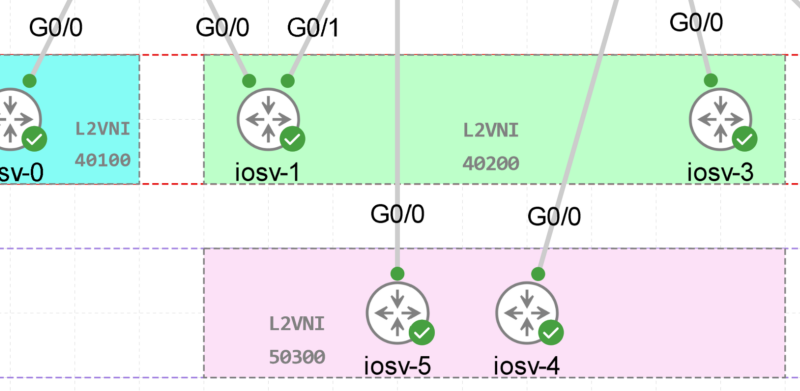OSPFv3 Basic Configuration Example [Step by Step GNS3 Lab]
![OSPFv3 Basic Configuration Example [Step by Step GNS3 Lab]](https://learnduty.com/wp-content/uploads/2022/06/image-22.png)
Contents
Lab Topology
- In this Lab, we have 3 routers participating in OSPFv3 single Area 0.
- Each router has an interface connected to the user interface.

Routers Configurations
We will start first with the configuration of each router in the Lab, we will assign IPv6 addresses to the interfaces and then configure the OSPFv3 process in order to form OSPFv3 adjacency between them:
Router R1 Configuration:
ipv6 unicast-routing
ipv6 cef
interface FastEthernet0/0
no ip address
speed auto
duplex auto
ipv6 address FE80::10 link-local
ipv6 ospf 10 area 0
!
interface FastEthernet0/1
no ip address
speed auto
duplex auto
ipv6 address 2001:DB8:0:10::1/64
ipv6 ospf 10 area 0
!
ipv6 router ospf 10
router-id 1.1.1.1Router R2 Configuration:
ipv6 unicast-routing
ipv6 cef
interface FastEthernet0/0
no ip address
speed auto
duplex auto
ipv6 address FE80::20 link-local
ipv6 enable
ipv6 ospf 10 area 0
!
interface FastEthernet0/1
no ip address
speed auto
duplex auto
ipv6 address FE80::20 link-local
ipv6 ospf 10 area 0
!
interface FastEthernet1/0
no ip address
duplex full
ipv6 address 2001:DB8:0:20::1/64
ipv6 ospf 10 area 0
!
ipv6 router ospf 10
router-id 2.2.2.2Router R3 Configuration:
ipv6 unicast-routing
ipv6 cef
interface FastEthernet0/0
no ip address
speed auto
duplex auto
ipv6 address FE80::30 link-local
ipv6 ospf 10 area 0
!
interface FastEthernet0/1
no ip address
speed auto
duplex auto
ipv6 address 2001:DB8:0:30::1/64
ipv6 ospf 10 area 0
!
!
ipv6 router ospf 10
router-id 3.3.3.3Verifications
first of all, we will check the status of the interfaces on each router and their IP6 routing tables:
On R1:
R1#show ipv6 int brief
FastEthernet0/0 [up/up]
FE80::10
FastEthernet0/1 [up/up]
FE80::C801:5AFF:FEF0:6
2001:DB8:0:10::1
R1#show ipv6 route
IPv6 Routing Table - default - 5 entries
Codes: C - Connected, L - Local, S - Static, U - Per-user Static route
B - BGP, R - RIP, H - NHRP, I1 - ISIS L1
I2 - ISIS L2, IA - ISIS interarea, IS - ISIS summary, D - EIGRP
EX - EIGRP external, ND - ND Default, NDp - ND Prefix, DCE - Destination
NDr - Redirect, O - OSPF Intra, OI - OSPF Inter, OE1 - OSPF ext 1
OE2 - OSPF ext 2, ON1 - OSPF NSSA ext 1, ON2 - OSPF NSSA ext 2, l - LISP
C 2001:DB8:0:10::/64 [0/0]
via FastEthernet0/1, directly connected
L 2001:DB8:0:10::1/128 [0/0]
via FastEthernet0/1, receive
O 2001:DB8:0:20::/64 [110/2]
via FE80::20, FastEthernet0/0
O 2001:DB8:0:30::/64 [110/3]
via FE80::20, FastEthernet0/0
L FF00::/8 [0/0]
via Null0, receive
On R2:
R2#show ipv6 int brief
FastEthernet0/0 [up/up]
FE80::20
FastEthernet0/1 [up/up]
FE80::20
FastEthernet1/0 [up/up]
FE80::C802:54FF:FE10:1C
2001:DB8:0:20::1
R2#show ipv6 route
IPv6 Routing Table - default - 5 entries
Codes: C - Connected, L - Local, S - Static, U - Per-user Static route
B - BGP, R - RIP, H - NHRP, I1 - ISIS L1
I2 - ISIS L2, IA - ISIS interarea, IS - ISIS summary, D - EIGRP
EX - EIGRP external, ND - ND Default, NDp - ND Prefix, DCE - Destination
NDr - Redirect, O - OSPF Intra, OI - OSPF Inter, OE1 - OSPF ext 1
OE2 - OSPF ext 2, ON1 - OSPF NSSA ext 1, ON2 - OSPF NSSA ext 2, l - LISP
O 2001:DB8:0:10::/64 [110/2]
via FE80::10, FastEthernet0/0
C 2001:DB8:0:20::/64 [0/0]
via FastEthernet1/0, directly connected
L 2001:DB8:0:20::1/128 [0/0]
via FastEthernet1/0, receive
O 2001:DB8:0:30::/64 [110/2]
via FE80::30, FastEthernet0/1
L FF00::/8 [0/0]
via Null0, receive
On R3:
R3#show ipv6 int brief
FastEthernet0/0 [up/up]
FE80::30
FastEthernet0/1 [up/up]
FE80::C803:3DFF:FECC:6
2001:DB8:0:30::1
R3#show ipv6 route
IPv6 Routing Table - default - 5 entries
Codes: C - Connected, L - Local, S - Static, U - Per-user Static route
B - BGP, R - RIP, H - NHRP, I1 - ISIS L1
I2 - ISIS L2, IA - ISIS interarea, IS - ISIS summary, D - EIGRP
EX - EIGRP external, ND - ND Default, NDp - ND Prefix, DCE - Destination
NDr - Redirect, O - OSPF Intra, OI - OSPF Inter, OE1 - OSPF ext 1
OE2 - OSPF ext 2, ON1 - OSPF NSSA ext 1, ON2 - OSPF NSSA ext 2, l - LISP
O 2001:DB8:0:10::/64 [110/3]
via FE80::20, FastEthernet0/0
O 2001:DB8:0:20::/64 [110/2]
via FE80::20, FastEthernet0/0
C 2001:DB8:0:30::/64 [0/0]
via FastEthernet0/1, directly connected
L 2001:DB8:0:30::1/128 [0/0]
via FastEthernet0/1, receive
L FF00::/8 [0/0]
via Null0, receive
And Finally, we check connectivity between the user PCs, for example, we will ping from PC1 to PC2:
PC1> show ipv6
NAME : PC1[1]
LINK-LOCAL SCOPE : fe80::250:79ff:fe66:6800/64
GLOBAL SCOPE : 2001:db8:0:10::a/64
ROUTER LINK-LAYER : ca:01:5a:f0:00:06
MAC : 00:50:79:66:68:00
LPORT : 10024
RHOST:PORT : 127.0.0.1:10025
MTU: : 1500
---------------------------
PC1> ping 2001:db8:0:20::a
2001:db8:0:20::a icmp6_seq=1 ttl=60 time=225.905 ms
2001:db8:0:20::a icmp6_seq=2 ttl=60 time=60.874 ms
2001:db8:0:20::a icmp6_seq=3 ttl=60 time=61.342 ms
2001:db8:0:20::a icmp6_seq=4 ttl=60 time=77.372 ms
2001:db8:0:20::a icmp6_seq=5 ttl=60 time=61.133 ms
